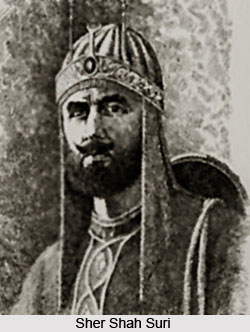 Revenue system during the reign of Sher Shah Suri was quite an efficient one. The main sources of income of the state were the land-revenue, unclaimed property, trade-tax, mint, salt-tax, khams, viz. one fifth of the plunder taken during the time of war, Jizya and presents from subordinate rulers, governors, nobles, traders etc. The main items of expenditure were the expenses to maintain the army, salaries of civilian officers and the expenditure of the royal household and the Sultan. The local taxes were levied mostly on production and consumption of various trade and professions and on transport. The land-revenue, however, constituted the primary source of income of the state. Sher Shah believed that the welfare of the state could be achieved only by looking after the welfare of the peasants. Therefore, he paid personal attention towards the revenue administration and introduced certain successful measures to improve it. His revenue administration has been regarded as one of the best during the medieval period.
Revenue system during the reign of Sher Shah Suri was quite an efficient one. The main sources of income of the state were the land-revenue, unclaimed property, trade-tax, mint, salt-tax, khams, viz. one fifth of the plunder taken during the time of war, Jizya and presents from subordinate rulers, governors, nobles, traders etc. The main items of expenditure were the expenses to maintain the army, salaries of civilian officers and the expenditure of the royal household and the Sultan. The local taxes were levied mostly on production and consumption of various trade and professions and on transport. The land-revenue, however, constituted the primary source of income of the state. Sher Shah believed that the welfare of the state could be achieved only by looking after the welfare of the peasants. Therefore, he paid personal attention towards the revenue administration and introduced certain successful measures to improve it. His revenue administration has been regarded as one of the best during the medieval period.
The system which Sher Shah introduced in most of the places was Ryotwari wherein the state kept direct relations with the peasants for the assessment and collection of the land revenue. However, the system could not be introduced in Multan, Malwa and Rajasthan where the Jagirdari system continued to exist. All cultivable land was divided into three categories on the basis of production, viz. good, middle and bad. The land was measured according to a uniform system and it was ascertained that what quality of land was possessed by each cultivator. An average of the produce was estimated in each case and then the cultivators were asked to pay one third of their produce to the state. The state preferred to collect revenue in the form of cash and for that purpose; prices of every variety of cereals were fixed at different places. The revenue on perishable articles was, however, paid by the peasants in form of cash only.
The peasants were given the facility to pay their revenue in installments in a year according to crop seasons. The peasants were given pattas (title deeds) by the state specifying the revenue which they had to pay and were asked to sign deeds of agreement signifying their acceptance to pay the required revenue. The peasants had also to pay two more taxes, named the surveyor`s fee and the tax-collector`s fee to the state. These constituted two per cent to five per cent of their produce. Besides these, the peasants had to pay two per cent of their produce in kind to be returned to them in case of any natural calamity such as flood, famine etc. According to the orders of the Sultan, the peasants were treated with generosity while fixing the revenue but once settled they were asked to pay their revenue without any mercy on behalf of the state.
The revenue administration of Sher Shah also suffered from certain defects. The peasants who possessed middle and bad quality of land had to pay more as compared to the owners of good quality land under this system. The annual settlement of the revenue was inconvenient both to the peasants and state-officials. There was corruption in the revenue department and Sher Shah failed to uproot it. That must have affected adversely the welfare of the peasants. Yet, the measures introduced by Sher Shah had largely succeeded in doing well to the peasants and increasing the income of the state. The revenue system of Sher Shah, therefore, has been regarded as fairly good as compared with the system of other rulers of medieval India.






































